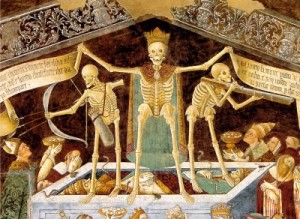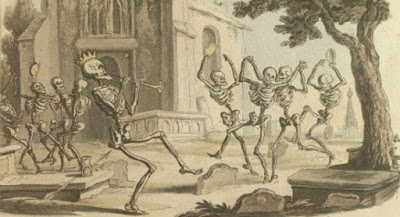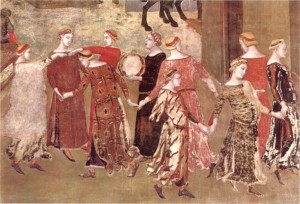In the Middle Ages to exorcise the fear of death, they danced with her, the living and the keletons are depicted all in a row in an endless farandola to leave life at dance step.
The most widespread theme in the early Middle Ages, however, was the Universal Judgment, a Memento Mori (As I am, you will be) that passed to the theme of the “Triumph of Death” as Danse Macabre.

In the Danse Macabre all the social categories of the medieval time are represented, starting with the powerful and the rich bourgeois and then gradually the artisans, the peasants and the poor.
With death crowned to direct the great ball and its attendants to throw the darts (or to shoot with the rifle as in the fresco of Clusone) or to play some musical instruments. Perhaps a sort of social satire, but it was rather a reflection on vanitas (of power and wealth).
The Shaking of the Sheets in the Middle Age
Ballo in Fa diesis minore (Angelo Branduardi)
The Doleful Dance Of Death (Tim Healy)
The Shaking of the sheets ( Steeleye Span)
Ad Mortem Festinamus (Llibre Vermell)
Passacaglia della Vita (anon. XVII sec)
Dance Macabre: la FARANDOLA
Su ballo tondo (from Sardigna- Italy)
Ankou (Breton trad)
Ballo in fa diesis minore
Angelo Branduardi “Ballo in fa diesis minore” from “La pulce d’acqua” 1997: if the text follows the motif of the medieval macabre dance, the music is instead a medieval tune from Giorgio Mainerio in his “Il primo libro dei balli accomodati per cantar et sonar d’ogni sorte de instromenti ” (1578) and it was more properly a “rain dance“
Guest of the album, the Sardinian musician Luigi Lai, virtuoso of the “launeddas“, very ancient wind instrument (here).
1.Sono io la Morte, e porto corona(1)
Io son di tutti voi signora e padrona
E così sono crudele, così forte sono e dura
Che non mi fermeranno le tue mura
2.Sono io la Morte, e porto corona
Io son di tutti voi signora e padrona
E davanti alla mia falce il capo tu dovrai chinare
E dell’oscura morte al passo andare
3.Sei l’ospite d’onore del ballo
che per te suoniamo
Posa la falce e danza tondo a tondo(2)
Il giro di una danza e poi un altro ancora
E tu del tempo non sei più signora
English translation *
I am Death and wear a crown,
I am for all of you lady and mistress
and I am so cruel, so strong and harsh
that your walls won’t stop me.
I am Death and wear a crown,
I am for all of you lady and mistress
and in front of my scythe you’ll have to bow your head
and walk to the gloomy Death’s pace.
You are the guest of honor at the dance
we are playing for you,
put your scythe down and dance round and round
a round of dancing and then one more,
and you’ll be no longer the lady of time.
FOOTNOTES
from https://lyricstranslate.com/en/ballo-fa-diesis-minore-dance-f-sharp-minor.html
(1) The text partly reproduces the inscription frescoed in the macabre dance of the Pinzolo Cemetery in Val Redena
“Io sont la Morte che porto corona
Sonte Signora de ognia persona
At cossi son fiera forte et dura
Che trapaso le porte et ultra le mura
Et son quela che fa tremare el mondo
Revolgendo una falze atondo atondo
Ovvio taco col mio strale
Sapienza, beleza forteza niente vale“
(2) men invite Death to dance so that he forget about his mission

The Shaking of the Sheets in the Middle Age
The spread of so many depictions of macabre dances on the walls of all Europe is traced back to the passage of the great plague of 1348 which decimated the populations without knowing boundaries. Never before had Europe known such a pestilence, though devastated by war and famine: entire villages disappeared and the fields filled with weeds because there was no one left to cultivate them. The chroniclers of the time wrote “A third of the world died”.
On the other hand, a “street” liturgical drama functional to preaching and perhaps related to the “Dance of the Maccabees” (chorea machabaeorum) in which the participants danced holding hands was already widespread at the level of the Sacred Drama (Morality Play). and they were taken away one by one by disturbing characters wrapped in a sheet.

THE SHAKING OF THE SHEETS/The Doleful Dance Of Death
[ Roud V11404 ; trad.]
“Shaking of the Sheets” was published in 1568 in “Popular Music of the Old Time” (Chappell) (cf). In the English Dancing Master, Playford transcribed the melody. Among the ritual representations of the mummers could not miss this song that Tim Healy founder of The Oxford Waits has reworked from the Broadside collections with the title The Doleful Dance Of Death (2003).
The song, however, re-proposed in a folk-rock key by the Steeleye Span follows some sixteenth-century stanzas but the music was composed by Robert “Bob” Johnson and mixed with a country dance titled Black Joke (Joack) from the village of Adderbury in Oxfordshire. Black Joak was transcribed by Cecil Sharp from the bearer John Mason of Stow-on-the-Wold, a traditional melody of the Morris Dance with the sticks of the same name.
The Doleful Dance Of Death (Tim Healy)
Can you dance the shaking of the sheets,
The dance that everyone must do?
Hear the drummer strike a noble beat,
The harp ring sweet and true.
Gather rosebuds while you may,
For when you hear the piper play,
You may to heaven dance away,
You may to heaven dance away.
You may fill your pockets up with gold
And dress all in rich array.
Wise or foolish, meek or bold,
There’s only a penny left to pay.
The poorest man is crowned complete
The day he finds his winding sheet,
For death is the man that all must meet,
Yes, death is the man that all must meet.
You may build your mansions high
With roaring fires to keep you warm.
Shut the shutters, bolt the gates,
Draw curtains tightly against the storm.
The strongest tower its hearth betrays
When my tune the minstrel plays,
A doleful dance to end your days,
A doleful dance to end your days.
The Shaking of the Sheets (Steeleye Span)
Chorus:
Dance, dance the shaking of the sheets,
Dance, dance when you hear the piper playing,
Everyone must dance
The Shaking of the Sheets with me.
I
Bring away the beggar, bring away the king,
And every man in his degree.
Bring away the oldest and the youngest thing,
Come to death and follow me.
II
Bring away the merchant who made his money in France,
And the crafty banker too,
When you hear the piper, you and I must dance
The dance that everyone must do.
Chorus
III
I’ll find you in the courtrooms, I’ll find you in the schools,
When you hear the piper play.
I’ll take away the wise men, I’ll take away the fools
And bring their bodies all to clay.
IV
All the politicians of high and low degree,
Lords and ladies, great and small.
Don’t think that you’ll escape
and need not dance with me,
I’ll make you come when I do call.
Chorus
V
It may be in the day, it may be in the night,
Prepare yourselves to dance and pray.
That when the piper plays
“The Shaking of the Sheets”
You may to Heaven dance the way.
Chorus
Dance Macabre: la FARANDOLA
La farandola is a medieval dance with a single basic step (mostly skipped), in which the row leader chooses the changes of direction, he makes and undoes just like the Norns with the thread of destiny. And therefore the farandola is the ritual dance in the celebrations of Samahin because it is the dance of death: everyone must travel the same path abandoning themselves to the will of those who lead the dance, to symbolize chained humanity that can only follow the path traced, and however a sort of collective journey through the experiences of life, towards its mysterious center. The farandola is probably the oldest dance so tied to the primitive agrarian rites: it is the dance of the labyrinth with its snail and snake figures, the dance around the fire, the sacred center of village life. Thus the labyrinth always has an exit and the dance is a dance of death and rebirth to symbolize the concept of eternal return.

The farandola is probably the oldest dance in the world dedicated to the Lady of the Labyrinth which we find in the Minoan culture of 1400 BC, a dance connected to the mysteries of fertility and described by Homer in the shield of Achilles.
In the figure (from the fresco by Ambrogio Lorenzetti- Palazzo del Buonconsiglio, Siena – Italy) the two women leaders raised their arms in an arc to let pass below the rest of the chain (which was already drawing a sinuous serpentine movement), just a tambourine and the voice to cadence the rhythm and from the lightness with which the dancers move it would seem that they dance on tiptoe without lean their heel.
The dance has kept its legacy in Provence as the traditional dance par excellence (for every occasion).
Su ballo tondo- from Sardigna (Italy)
LINK
http://gianfrancomarini.blogspot.it/2011/09/danza-macabra-sciarazula-marazula-e.html
http://lanimadelmostro.blogspot.it/2016/11/danza-di-ossa-novembrine-parte-i.html
http://lanimadelmostro.blogspot.it/2016/11/danza-di-ossa-novembrine-parte-ii-danze.html
http://lanimadelmostro.blogspot.it/2016/11/danza-di-ossa-novembrine-parte-iii.html
http://www.mariateresalupo.it/simbolimitialchimiafiabe/labirinto.html
http://www.kronic.it/artGet.aspx?cID=12746
http://www.latelanera.com/abisso/articolo.asp?id=183 http://www.8notes.com/scores/6264.asp http://mainlynorfolk.info/steeleye.span/songs/shakingofthesheets.html
http://thesession.org/tunes/7110
http://www.famedisud.it/arte-da-sud-la-misteriosa-danza-delle-nove-donne-di-ruvo-al-museo-archeologico-di-napoli/
http://www.sardegnadigitallibrary.it/index.php?xsl=2436&id=1132

